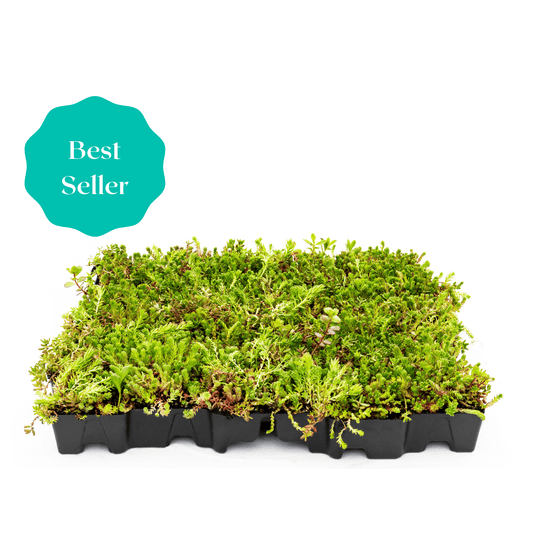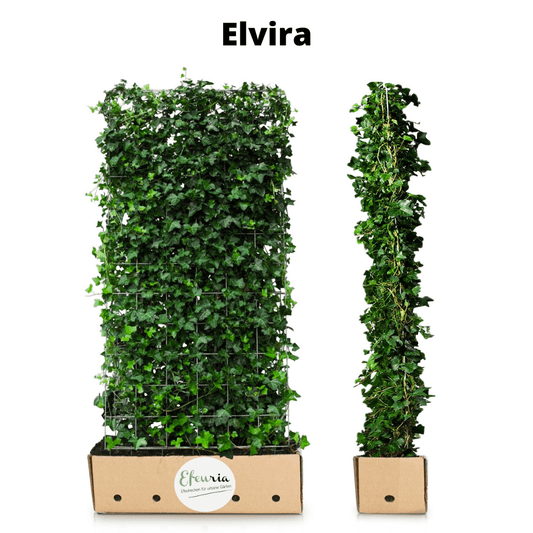The Hedge Navigator - Comparison of garden hedges
Share
Which garden hedge is suitable as a privacy screen for modern urban gardens?
When people think of a garden hedge, they often think of a cherry laurel or privet hedge. Garden hedges as a privacy screen are more cost-effective, take up less space, and are more durable than a wall or a wooden screen. The disadvantage is that they have to be trimmed once or twice a year. Depending on the size of the hedge plant, you will need a few years of patience and care until the planted privacy screen has grown tall and is opaque. In a small garden, cherry laurel or privet hedges can quickly feel cramped because, at a height of 160 to 220 cm, they quickly become very bushy and therefore take up a lot of space in the garden. Space is often lacking in modern urban gardens because land prices have risen dramatically, and gardens are therefore generally smaller.
Cherry laurel hedge as a privacy screen
The leaves of the cherry laurel are slightly glossy and evergreen, making them a perfect year-round hedge, providing privacy. The foliage becomes opaque after a few years. Cherry laurel generally doesn't shed its leaves even in winter, so it produces little foliage. Depending on the variety, the white blossoms emit a pleasant fragrance. It's therefore not surprising that cherry laurel lends a contemporary look to many modern gardens. That's why I often see the plant near modern, new townhouses.
The disadvantage is that cherry laurel quickly becomes very bushy due to its rapid and vigorous growth. Young plants are usually planted 50 cm apart. Cherry laurel is one of the more expensive hedge alternatives. It takes about five years to establish a reasonably dense and tall hedge in your garden. If the hedge is opaque, it can easily reach a width of 70 to 100 cm at the top. In many urban gardens, the hedge grows even further. This space is then lacking in modern urban gardens, creating an even more cramped atmosphere.

Privet hedge as a privacy screen
Privet is clearly one of the classic hedge plants. It is robust and requires little sun. The leaves are very fine, between two and four centimeters long, and provide effective privacy in the garden. Combined with the fine branches and small leaves, the hedge grows very quickly, becoming opaque and graceful. One advantage is that you can trim the hedge into attractive, rounded shapes. Birds like to nest inside the hedge, as there is plenty of space inside. Depending on the type of plant, privet can reach a height of up to five meters. The advantage is that privet is uncomplicated, site-tolerant, tolerates pruning, low-maintenance, tolerates sun and partial shade, and is relatively inexpensive.
The disadvantage is that privet loses some of its leaves in winter. Just like bay hedges, this hedge quickly becomes bushy and, at a height of 160 cm to 220 cm, quickly becomes enormously wide, taking up a lot of space in the garden. Unfortunately, this is precisely what is lacking in modern urban gardens. This is certainly the reason why this type of hedge is rarely found in modern new buildings.
What should a modern hedge look like?
If we think of modern townhouses and modern urban gardens, the gardens are smaller than they were 20 years ago. For these gardens, we need a hedge that grows very quickly, is evergreen year-round, and also opaque. Furthermore, the hedge should take up only a minimal amount of space in our beautiful urban garden. The hedge should not take up more than 20 cm of width. If possible, the hedge should also replace the garden fence and thus keep out unwanted visitors. Does this super alternative even exist?
Ivy as an evergreen hedge plant
The modern homeowner doesn't immediately picture ivy when they think of their urban garden. Ivy is more commonly known as a vigorous climber. Its shoots love to grow up walls and fences and cling to them. This no longer does justice to the venerable ivy. If properly cared for, ivy can form a beautiful, evergreen, and opaque hedge. The advantage is that it is completely opaque even in winter. It is easy to care for, very site-tolerant, can be pruned year-round, and compared to other hedge plants, it copes very well with shade. Ivy's real advantage, however, is that it can form a very narrow hedge, only a few centimeters wide. These qualities make ivy, with regular pruning and care, an attractive choice for urban gardens and even balconies. There are basically two types of ivy that are suitable. Large-leaved ivy (Hedera hibernica), also known as Irish ivy, and common ivy (Hedera helix). Both species are hardy, evergreen, tolerate pruning, and love to grow. They have leathery, glossy leaves. Those who expect bright flowers will have to forgo them with ivy. After about ten years, ivy forms small, rather inconspicuous, greenish flower umbels in September. These flowers are an important food source for insects, even before the winter break, when other hedge plants have already lost their leaves. If left to its own devices, ivy will readily overgrow its entire surroundings with its shoots.

The ivy leaf is green in summer and takes on a
reddish color
How to plant ivy correctly as an evergreen hedge
To form a tall, slender hedge, ivy requires a trellis to support its growth. The trellis can be a wooden frame or a wire mesh trellis. The ivy climbs upward around this trellis, creating a slender, opaque, green ivy wall.
How do you plant an ivy hedge?
Ivy is easy to plant yourself without the expense of hiring a landscaper. Mark the desired location with spray paint, sand, or a string line. Then dig a trench along the mark and remove any stones and larger roots. There are several methods for erecting a trellis. You can build a trellis from chain-link fence or build one yourself. A chain-link fence is permanently stable, but also somewhat more expensive. Hardware stores sell drive-in sleeves if you decide to build a trellis yourself. Insert the appropriate fence posts into these drive-in sleeves. Alternatively, you can drive the posts directly into the ground. It is important that the posts are exactly the same height as your hedge. Use approximately two posts per meter if you want to attach a chain-link fence to them. If you are attaching a wire mesh to the posts, a distance of one meter between each post is sufficient. Sprinkle some potting soil into the groove. Now plant four to five ivy plants per meter in the planting channel and attach the ivy tendrils to the trellis.
Planting ivy as a ready-made hedge
Anyone who wants to sit in front of a finished, opaque, and green ivy hedge that same evening can choose from ready-made ivy hedge panels measuring 120 cm wide and between 100 and 220 cm high. These panels save the gardener the wait until the plants have reached the desired height and are opaque enough for a patio or garden. Each ivy module consists of a trellis, a seed ball, and approximately five ivy plants that have been nurtured to their height over several years. The modules are conveniently lined up one after the other. Posts are placed between the modules for stability, to which the trellis is attached with wire or plastic clips. You can also plant the ready-made hedge modules in planters and place them on balconies or patios. With these modules, you save yourself the hassle of training the ivy shoots, as the shoots are already firmly attached to the trellis. This way, the dream of an opaque, green ivy fence becomes reality within about four hours.
>> Tip : Use our Efeuria hedge calculator : Calculate in 3 steps how many hedge elements and accessories you need. Experience the ease of garden planning!

>> Curious ? Find ready-made ivy hedges in our Efeuria shop .
What does proper ivy care look like?
Caring for an ivy hedge is child's play. There's no season to consider. The ivy shoots can be trimmed regularly or woven into the fence. However, you should maintain the hedge regularly, otherwise the shoots will curiously invade their surroundings. Ivy thrives in both sun and shade. The more water it receives, the more sun it can tolerate. Ivy prefers partial shade or shade, rather than direct sunlight. Because the hedge forms a vertical ivy wall, the ivy is inevitably shaded regularly. Therefore, you don't have to worry about its position in the garden. Ivy doesn't really care about the soil, as it thrives in almost any type of soil. Ivy thrives in slightly permeable and slightly moist soil.

Ivy hedges can cope with both shade and sun in the garden and form a slender wall of about 20 cm
How and when do you prune ivy?
Ivy hedges should be trimmed twice a year to ensure they retain their slender, space-saving shape for urban gardens. You can do this without feeling guilty, as the privacy screen is not compromised. Ivy is tough, and you don't need to pay attention to anything or be particularly careful. Ivy recovers very quickly from cutting back because it is so vigorous. If the shoots are short, you can wind them back into the hedge. If the shoots are a bit longer, you can use electric pruning shears. This saves time and does absolutely no harm to the ivy. If possible, trim the ivy in cloudy weather. This way, the exposed leaves, which are not yet used to direct sunlight, do not receive direct sun. The best months for hedge maintenance are April and September. If that's too much for you, you can trim your hedge once in August.
Ivy as a hedge plant: The most important things in brief
- The best time to plant ivy is in spring. This allows the vines to work their way up the trellis.
- Dig a trench along the line where you want to plant ivy. Fill the trench with potting soil.
- Drive stakes into the ground to attach trellises or a chain-link fence.
- Plant approximately four to five ivy plants per meter in the soil.
- Attach the shoots to the trellis and trim the ivy about twice a year. If that's too much work for you, you'll find ready-made ivy panels in our shop, measuring 120 cm wide and 180 or 220 cm high. The panels are only 20 cm wide, and any number of panels can be strung together.
>> For those who don't want to wait: Here you can find our ready-made ivy hedges, which can be ordered online and delivered directly to your home.







